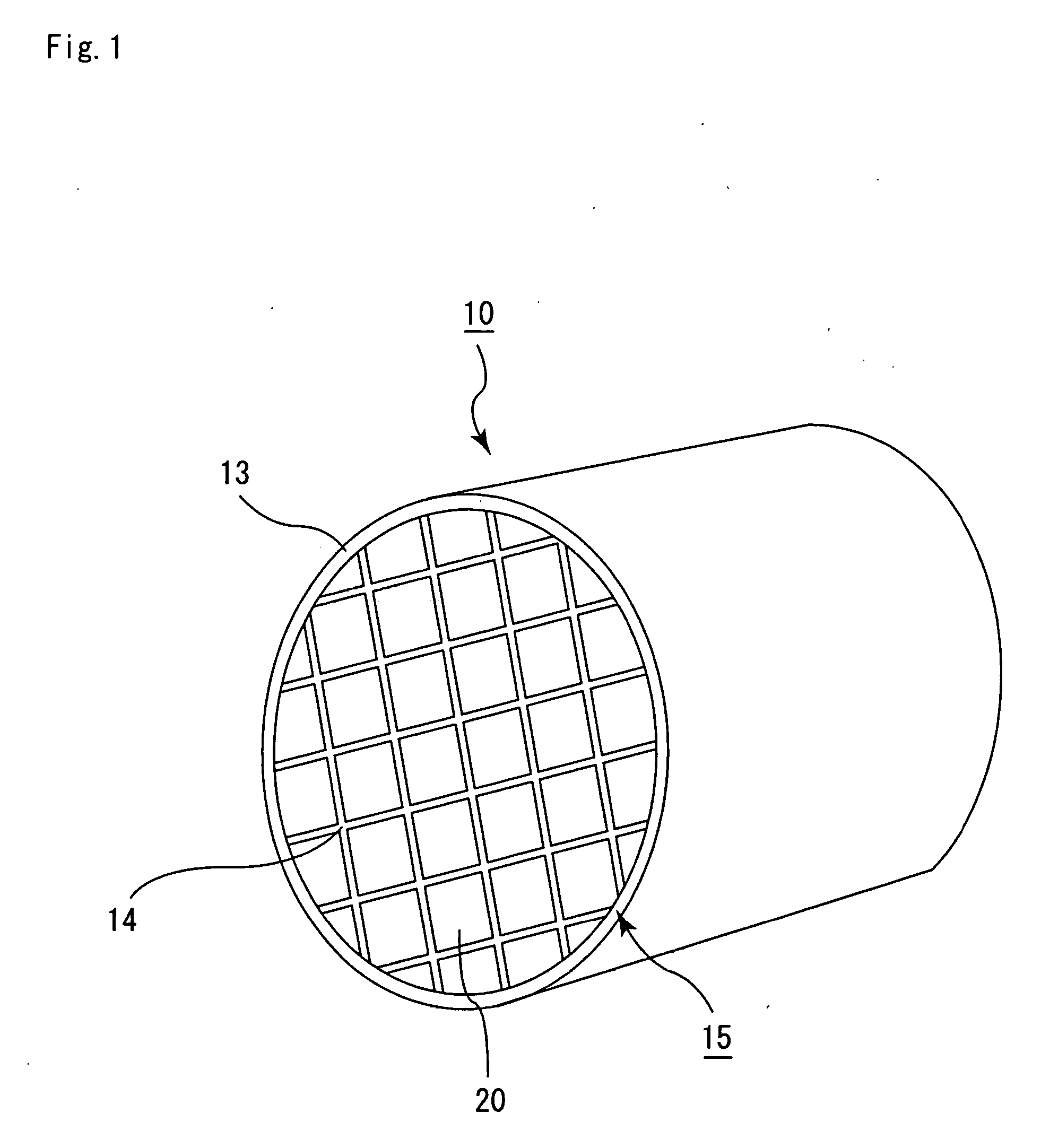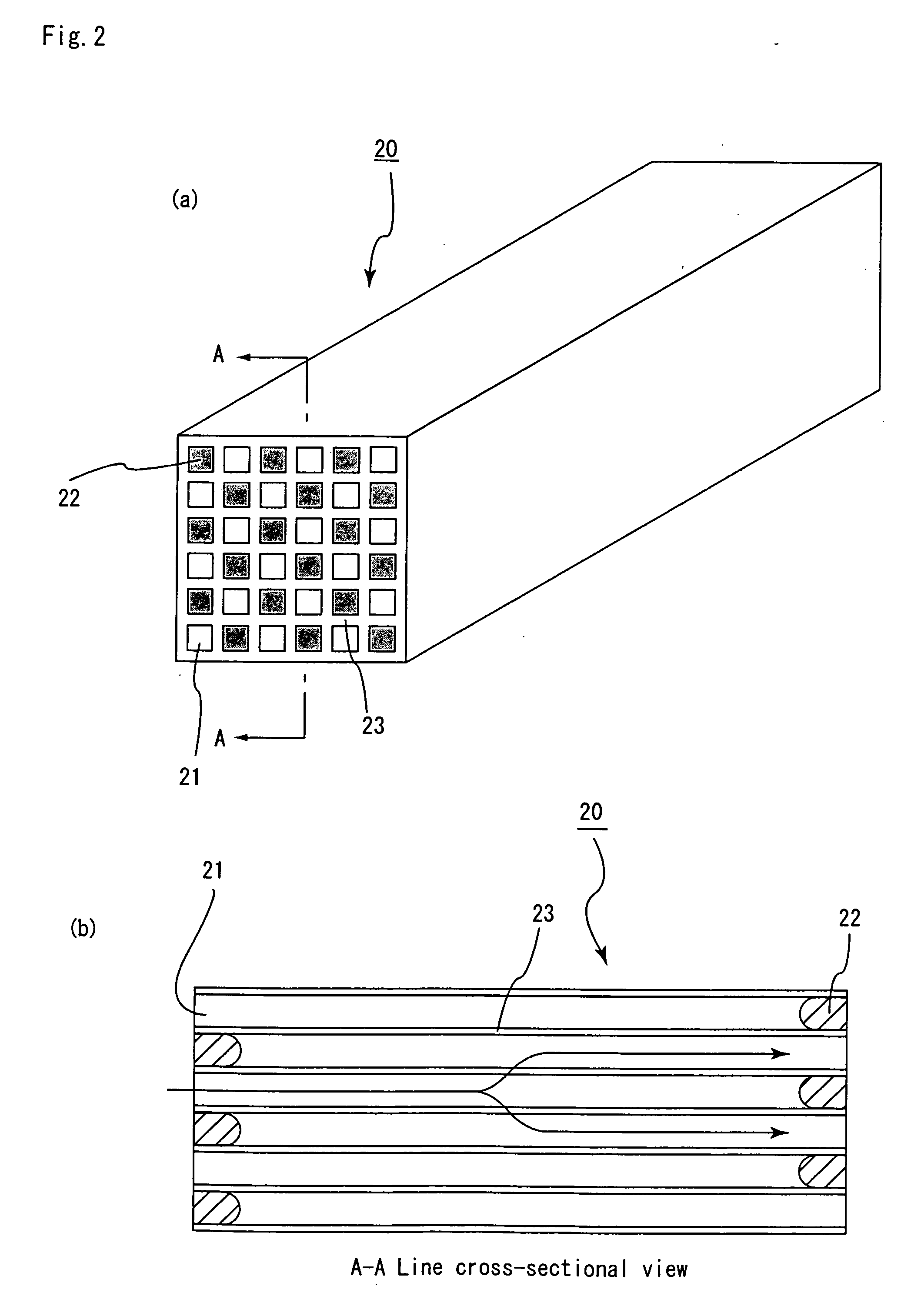Honeycomb filter for exhaust gas decontamination, adhesive, coating material and process for producing honeycomb filter for exhaust gas decontamination
a technology of exhaust gas decontamination and honeycomb filter, which is applied in the field of honeycomb filter, can solve the problems of affecting the permeability of gas, the presence of exhaust gases, and the formation of particles, and achieves the effects of reducing the number of contaminated particles
- Summary
- Abstract
- Description
- Claims
- Application Information
AI Technical Summary
Benefits of technology
Problems solved by technology
Method used
Image
Examples
example 1
[0397] (1) Powder of α-type silicon carbide having an average particle size of 5 μm (60% by weight) and powder of β-type silicon carbide having an average particle size of 0.5 μm (40% by weight) were wet-mixed, and to 100 parts by weight of the resulting mixture were added and kneaded 5 parts by weight of an organic binder (methyl cellulose) and 10 parts by weight of water to obtain a kneaded matter. Next, after a slight amount of a plasticizer and a lubricant had been added to the kneaded matter and this had been further kneaded, the resulting kneaded matter was extrusion-formed so that a raw formed product was manufactured.
[0398] Next, the above-mentioned raw formed body was dried by using a microwave drier, and predetermined through holes were then filled with a paste having the same composition as the raw formed body, and after this had been again dried by using a drier, this was degreased at 400° C., and sintered at 2200° C. in a normal-pressure argon atmosphere for 3 hours to...
example 2
[0402] (1) The same processes as (1) of Example 1 were carried out to obtain a porous ceramic member.
[0403] (2) The same processes as Example 1 were carried out except that a heat-resistant adhesive paste, prepared by adding 25 parts by weight of water to 100 parts by weight of a mixture composed of 15.7% by weight of alumina fibers having a fiber length of 0.2 mm, 54.2% by weight of silicon carbide particles having an average particle size of 0.6 μm, 8.1% by weight of silica sol, 2.0% by weight of carboxymethyl cellulose and 20% by weight of ammonium hydrogencarbonate serving as a foaming agent, was used to manufacture a honeycomb filter.
example 3
[0404] (1) The same processes as (1) of Example 1 were carried out to obtain a porous ceramic member.
[0405] (2) The same processes as Example 1 were carried out except that a heat-resistant adhesive paste, prepared by adding 35 parts by weight of water to 100 parts by weight of a mixture composed of 13.7% by weight of alumina fibers having a fiber length of 0.2 mm, 47.4% by weight of silicon carbide particles having an average particle size of 0.6 μm, 7.1% by weight of silica sol, 1.8% by weight of carboxymethyl cellulose and 30% by weight of ammonium hydrogencarbonate serving as a foaming agent, was used to manufacture a honeycomb filter.
PUM
| Property | Measurement | Unit |
|---|---|---|
| temperature | aaaaa | aaaaa |
| porosity | aaaaa | aaaaa |
| porosity | aaaaa | aaaaa |
Abstract
Description
Claims
Application Information
 Login to View More
Login to View More - R&D
- Intellectual Property
- Life Sciences
- Materials
- Tech Scout
- Unparalleled Data Quality
- Higher Quality Content
- 60% Fewer Hallucinations
Browse by: Latest US Patents, China's latest patents, Technical Efficacy Thesaurus, Application Domain, Technology Topic, Popular Technical Reports.
© 2025 PatSnap. All rights reserved.Legal|Privacy policy|Modern Slavery Act Transparency Statement|Sitemap|About US| Contact US: help@patsnap.com



